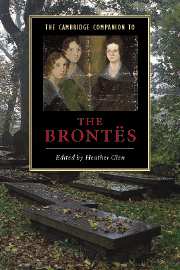Book contents
- Frontmatter
- Introduction
- 1 The Haworth context
- 2 'Our plays': The Brontë Juvenilia
- 3 The poetry
- 4 'Three distinct and unconnected tales': The Professor, Agnes Grey and Wuthering Heights
- 5 'Strong family likeness': Jane Eyre and The Tenant of Wildfell Hall
- 6 Shirley and Villette
- 7 'Getting on': ideology, personality and the Brontë characters
- 8 Women writers, women's issues
- 9 The Brontës And Religion
- 10 The Brontë myth
- Further reading
- Index
- Series List
8 - Women writers, women's issues
Published online by Cambridge University Press: 28 May 2006
- Frontmatter
- Introduction
- 1 The Haworth context
- 2 'Our plays': The Brontë Juvenilia
- 3 The poetry
- 4 'Three distinct and unconnected tales': The Professor, Agnes Grey and Wuthering Heights
- 5 'Strong family likeness': Jane Eyre and The Tenant of Wildfell Hall
- 6 Shirley and Villette
- 7 'Getting on': ideology, personality and the Brontë characters
- 8 Women writers, women's issues
- 9 The Brontës And Religion
- 10 The Brontë myth
- Further reading
- Index
- Series List
Summary
In chapter 9 of Shirley, Charlotte Brontë gives us a brief, vivid description of the Yorke family's domestic life. Among the six children, the twelve-year-old Rose stands out for her strength of character. Although her strong-minded, dour mother would like to turn Rose into a copy of herself, 'a woman of dark and dreary duties', the girl is of a very different, independent mould. She has 'a mind full-set, thick-sown with the germs of ideas her mother never knew' and it 'is agony to her often to have these ideas trampled on and repressed' (S, 148). Later, Rose shares her impressions of Ann Radcliffe’s The Italian with Caroline Helstone: the gothic romance, she says, feeds her longings to travel, and she expansively gestures to the breadth of her hunger for experience:
‘The whole world is not very large compared with creation: I must see the outside of our own round planet at least.’
‘How much of its outside?’
‘First this hemisphere where we live; then the other.I am resolved that my life shall be a life: not a black trance like the toad’s buried in marble; nor a long, slow death like yours in Briarfield Rectory.’
(S, 399)- Type
- Chapter
- Information
- The Cambridge Companion to the Brontës , pp. 170 - 191Publisher: Cambridge University PressPrint publication year: 2002
- 1
- Cited by

